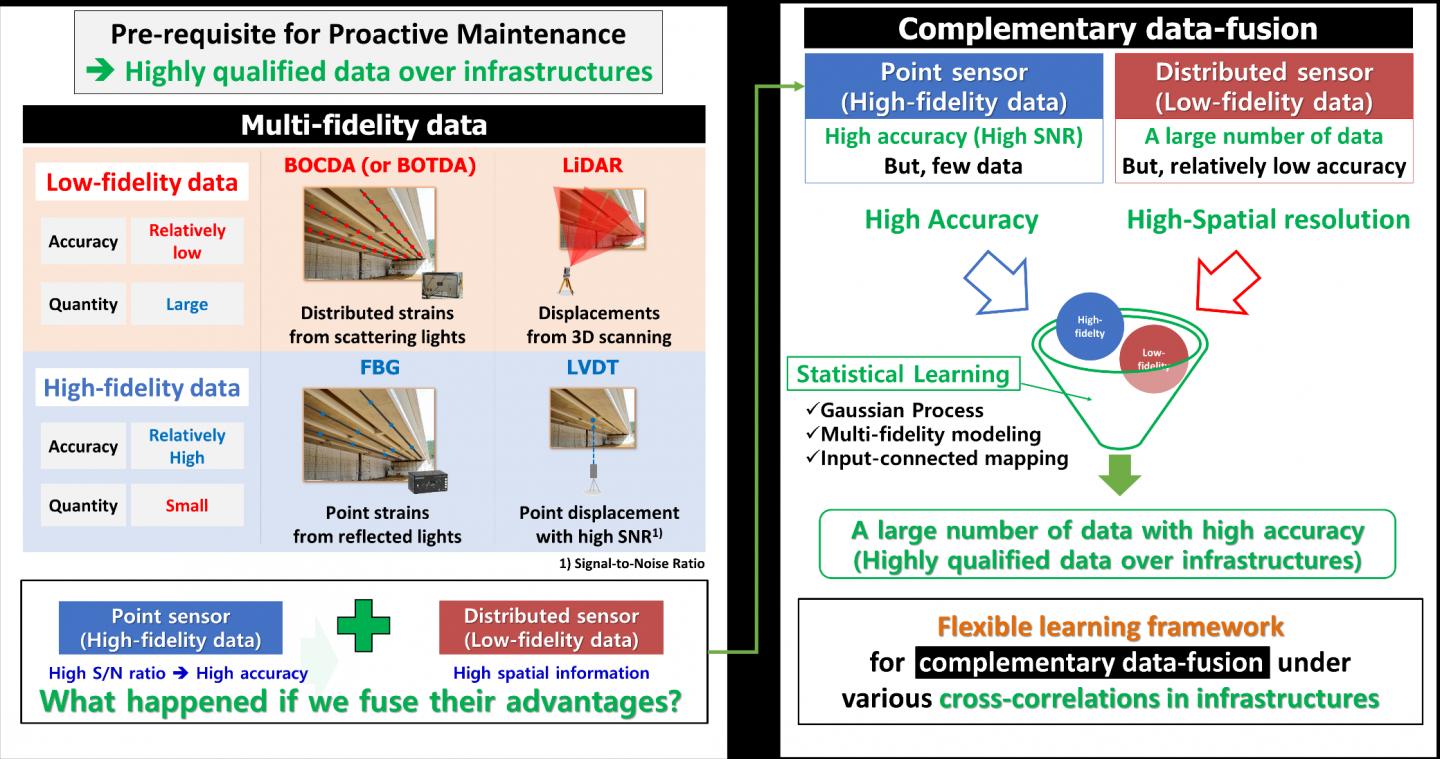VISUALIZATION
KICT's solution for monitoring massive infrastructures
A trailblazer for developing a new paradigm for structural monitoring
The Korea Institute of Civil Engineering and Building Technology (KICT) has announced the development of an effective structural monitoring technique to monitor massive infrastructures, such as long-span bridges. The method provides accurate and precise responses over the whole structural system densely by fusing the advantages of multi-fidelity data.
Rapid advances in sensing and information technologies have led to condition-based monitoring in civil and mechanical structural systems. The structural monitoring system plays a key role in condition-based monitoring to evaluate structural safety from responses measured by sensors. In other words, the following method allows examining the health of existing structures, such as a long-span bridge. The structural monitoring system can enable early detection for an unsafe condition and enable proactive maintenance. As a result, it greatly reduces the inspection burden as well as maintenance costs. The prerequisite for successful condition-based monitoring is to obtain accurate responses through the whole structural system. Especially in civil-infrastructures, high cost, and technical difficulty are some challenging issues.

To solve this problem, a research team in KICT, led by Dr. Seung-Seop Jin, has developed an effective as well as an efficient data-fusion method for condition-based monitoring. With the following method, the complementary data-fusion for the point and distributed strain sensor is performed to combine their advantages to obtain the accurate strain distribution over whole infrastructures; thereby, responses can be estimated with high accuracy densely over whole infrastructures.
For structural response, the multi-fidelity data consists of point and distributed sensors, which have different fidelities. The point sensor provides highly accurate and reproducible responses at discrete measurement positions (High-fidelity data, HF-data), while a distributed sensor utilizes the scattering-based or scanning sensing technique to obtain very dense responses using the quasi-continuous sensing (Low-fidelity data, LF-data). The LF data is relatively easy to acquire, so it is possible to produce large amounts of relatively inaccurate data for response trends over the whole infrastructure. On the contrary, the HF data provides high accuracy; however, it is limited to acquire in terms of both time and technical limitations. Therefore, a limited amount of data is available and this can significantly impair the ability to diagnose structural conditions over whole infrastructures. Although they can be complemented each other, their complementary data-fusion has not been studied yet for the structural monitoring system. KICT firstly recognizes their potentials and developed the complementary data-fusion framework by exploiting multi-fidelity modeling in Computational statistics and Geo-statistics. The basic concept of the developed method is to transfer knowledge of the abundant but potentially inaccurate LF-data (response trend) to enhance their accuracies by fusing the information from the HF-data (accuracy at some points).
The newly developed method was verified by several numerical tests with other existing multi-fidelity data-fusion methods. To consider possible situations in real applications, the developed method was extensively evaluated through Monte Carlo simulations by varying the number and locations of multi-fidelity data with the noise. The results show that the prediction performance of the developed method is consistently superior to other existing methods. In both experiments, the relative percentages of accuracy (maximum absolute error) are improved up to 171.3% and 192 % to the existing methods.
The method is very versatile for structural monitoring, especially for massive infrastructures. The developed method is currently improved to make it more robust and efficient. For better-generalized capability, the developed method requires flexible learning capability for extracting the information from both the HF-data and LF-data and fusing them. Such improvements include the following.
Dr. Jin said, "The rationale behind this improvement is similar to our decision-making in real life. We seek different options and combine them to make the best decision. Similar to our decision-making, we do not have high confidence in the unknown damages. In the current method, we have to utilize specific models and some parameters of these models. It should be noted that the best model and its parameters are case-dependent. Therefore, we pursue several options for flexible modeling. To deal with various conditions in infrastructures, we can adopt a flexible and self-learning framework such as optimal kernel learning for better data fusion. This idea takes a step towards autonomous and efficient monitoring system for massive infrastructures."
